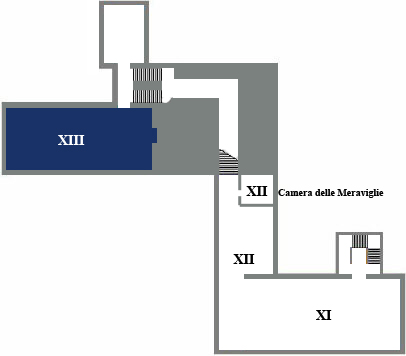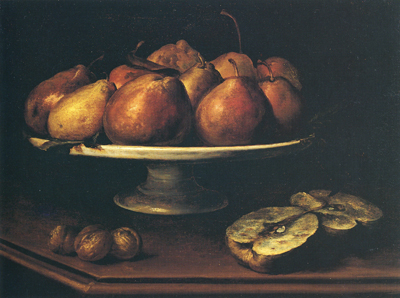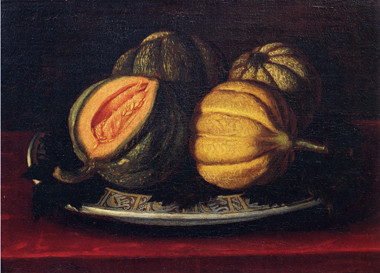|

Room XIII is given over to the still-life paintings.
When the artistic genres were ranked in the 17th century, the still life was placed in the lowest ranks, the highest being assigned to historical representations, and it thus became an exercise for apprentices. This genre, which acquired autonomous status at the end of the 16th century and then developed through the following century, was just as popular in Italy as in the Flemish countries.
|
|
Andrea Belvedere
Still life with tulips in a vase
end of 18th century
Andrea Belvedere, a Neapolitan painter and scene-painter, is the author of the Vase of tulips. On a dark background and with an almost circular arrangement, the flower is described in all of its phases, from the opening of the petals to the moment of wilting. The tulip is here a metaphor of passing time, of life's inexorable course.
|
|
Cristoforo Munari
Still life with fruit, chinaware and musical instruments
Still life with fruit, books, plates and musical scores
1710-1720
The two related canvases were painted in the decade between 1710 and 1720. They express an exaltation of the senses, evoked by the tactility of the fabrics, the sound of the instruments, the taste and smell of the picked fruit. The musical scores visible on one side link up with the musical instruments on the other. The objects represented are however marked by the course of time and the fleetingness and vulnerability of life; many of them have lost their function, like the overturned plates or the Milanese mandolin with the broken string.
|
|
|
Anonymous Roman
Table laid with flowers and fruit
1630-40
The large canvas datable to the third/fourth decades of the 17th century is recognisable as belonging to the Roman artistic context and particularly reflects the style of the Master of Hartford, the conventional name of an anonymous painter. The painting shows a Table laid with flowers and fruit; behind the pomegranates a vase of blue and white irises, a robin perched on a vine tendril and in the dark background a butterfly in flight. A beam of light from the top left corner obliquely strikes the single objects on the table which are arranged like stage props, emphasising them and creating strong contrasts, as though trying to stop the course of time.
|
|
Fede Galizia
Still life with centre-piece of pears
c. 1630
The painting is unanimously retained to be the work of Fede Galizia, a female Trento painter of Lombard culture. As is typical of this artist's pictorial language, the still life is characterised by a simple composition and refined dominant dark brown tones. Some pears are arranged in a majolica fruit-stand, at the base of which on the edge of the table are three walnuts, the symbol of the crucifixion; one pear is cut in half and already rotten, seeming to allude to the fleetingness of life.

|
|
Panfilo Nuvolone
Majolica plate with fruit
Beginning of 17th century
This canvas, datable to around the beginning of the 17th century, is probably the work of the Lombard painter, Panfilo Nuvolone. On a bright red table stands a decorated majolica plate containing four melons in varying stages of ripening, one of which is cut open. Again fruit is used to symbolise the brevity of life and the inexorable course of time.

|
|